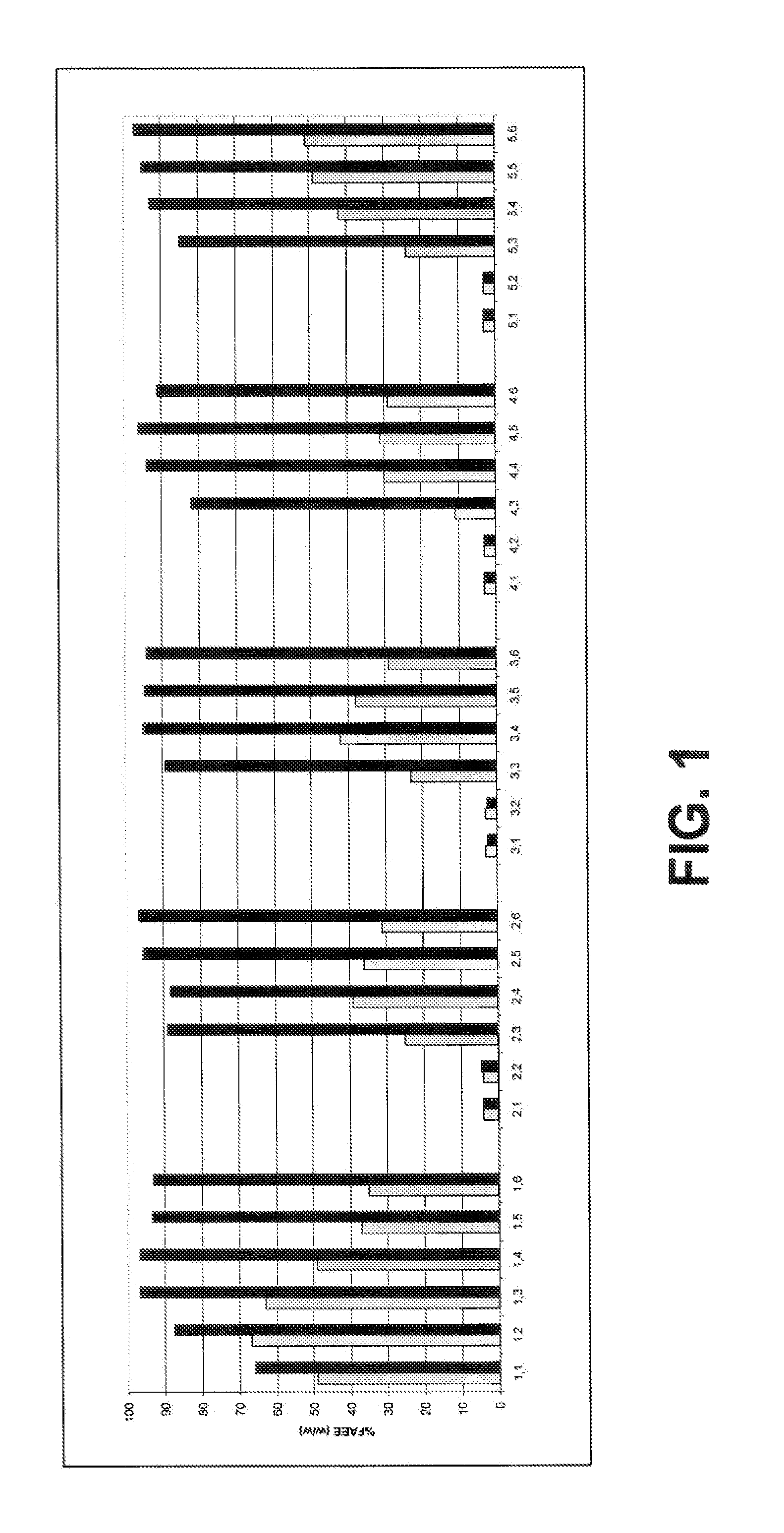Enzymatic production of fatty acid ethyl esters
a technology enzymes, which is applied in the field of enzyme-based production of fatty acid ethyl esters, can solve the problems of insufficient technology for re-using enzymes, lack of available cost-effective enzymes, and inability to commercialize biodiesel production, and achieves the destabilizing effect of alcohols on lipolytic enzymes that seems to decrease, and the stability of lipolytic enzymes is affected. ,
- Summary
- Abstract
- Description
- Claims
- Application Information
AI Technical Summary
Benefits of technology
Problems solved by technology
Method used
Image
Examples
example 1
Re-use of Immobilized Thermomyces lanuginosa Lipase in Batch Synthesis of FAEE Using 1-6 eq. EtOH
[0082]We studied the synthesis of fatty acid ethyl esters using soybean oil (SBO) and ethanol (EtOH) in a reaction catalyzed by Thermomyces lanuginosa lipase (TLL) immobilized on silica (Novozymes A / S, Bagsvrd, Denmark). The FAEE reactions were performed in 100 mL screwcap conical flasks. 20 mL SBO and 1 g immobilized enzyme were added to each flask. The amount of EtOH added varied from 1 to 6 molar equivalents relative to the total amount of fatty acids in the oil (i.e. [EtOH]:[FA]). EtOH was added step-wise in three equal portions at t=0 h, t=2 h, and t=4 h. To initiate the reactions, the first portion of EtOH was added and the flasks were closed and placed in a water bath orbital shaker at 35° C.
[0083]The conversion to FAEE was followed by 1H NMR analysis. Hence, aliquots of 20 microliter were withdrawn from the reaction mixture for analysis after 4 h and after 24 h where the reaction...
example 2
Re-Use of Immobilized Thermomyces lanuginosa Lipase in Batch Synthesis of FAEE with a Solvent Wash Between Cycles
[0086]This experiment was conducted essentially as the experiment described in Example 1 with the following amendments. Only 2.0 eq. and 3.5 eq. EtOH were tested. The EtOH was added step-wise at t=0 h: 0.5 eq.; t=2 h: 0.5 eq.; t=4 h: 1 eq. (for at total of 2 eq.) or at t=0 h: 1 eq.; t=2 h: 1 eq.; t=4 h: 1.5 eq. (for a total of 3.5 eq.). After each cycle, the reaction mixtures were decanted from the immobilized enzyme and submitted to the following treatments: a) no wash; b) wash with hexane; or c) wash with tert-butanol (t-BuOH). After the treatment, new SBO and EtOH were added and the next reaction cycle initiated (i.e. no attempt to remove residual solvent by drying the enzyme). Samples for NMR analysis were taken after 6 h and 24 h.
TABLE 2Content of FAEE (% w / w) using 2 eq. EtOHNo washHexane washt-BuOH washCycle no.6 h24 h6 h24 h6 h24 h187100858676872885405324242341212...
example 3
Re-Use of Immobilized Thermomyces lanuginosa Lipase in Batch Synthesis of FAEE with One-Step / Bulk Addition of EtOH
[0088]This experiment was conducted essentially as the experiment described in Example 1 with the following amendment. EtOH was not added step-wise but added in bulk at t=0 h.
TABLE 4Content of FAEE (% w / w) after 4 h / 24 h.EtOHCycle no.1 eq.2 eq.3 eq.4 eq.5 eq.6 eq.163 / 7217 / 8610 / 827 / 748 / 655 / 6224 / 4 5 / 10 3 / 676 / 574 / 495 / 4233 / 33 / 5 5 / 635 / 394 / 323 / 3743 / 34 / 6 5 / 316 / 365 / 263 / 2253 / 33 / 4 3 / 293 / 293 / 193 / 1763 / 33 / 3 3 / 204 / 233 / 193 / 1273 / 33 / 3 3 / 183 / 193 / 123 / 1084 / 5 5 / 214 / 174 / 113 / 109 3 / 11 4 / 364 / 363 / 293 / 4610- / - 6 / 335 / 294 / 263 / 20
[0089]The results show that below 3.0 eq. EtOH, enzymatic activity is quickly lost and at least 3 eq. EtOH some enzymatic activity is preserved through the 10 cycles. In comparison with a step-wise addition as described in example 1 the one-step or bulk addition of EtOH is clearly detrimental for the enzyme. Accordingly, a step-wise or alternatively a continuous addition of Et...
PUM
| Property | Measurement | Unit |
|---|---|---|
| reaction time | aaaaa | aaaaa |
| molar ratio | aaaaa | aaaaa |
| molar ratio | aaaaa | aaaaa |
Abstract
Description
Claims
Application Information
 Login to View More
Login to View More - R&D
- Intellectual Property
- Life Sciences
- Materials
- Tech Scout
- Unparalleled Data Quality
- Higher Quality Content
- 60% Fewer Hallucinations
Browse by: Latest US Patents, China's latest patents, Technical Efficacy Thesaurus, Application Domain, Technology Topic, Popular Technical Reports.
© 2025 PatSnap. All rights reserved.Legal|Privacy policy|Modern Slavery Act Transparency Statement|Sitemap|About US| Contact US: help@patsnap.com

